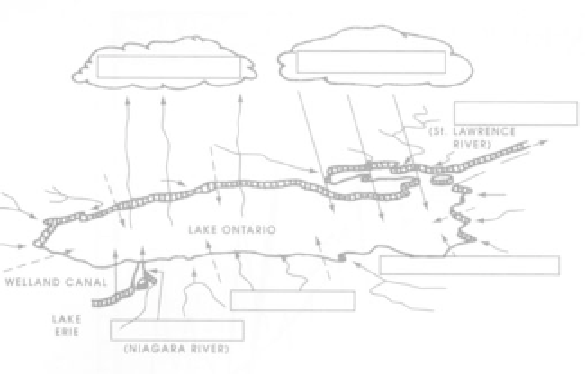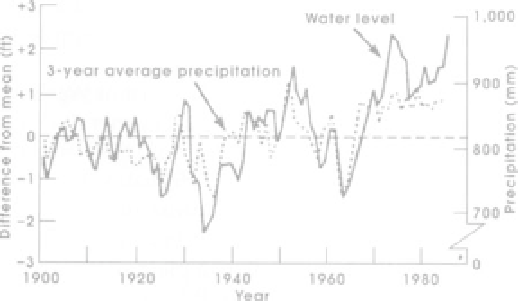Geology Reference
In-Depth Information
Exercise 11 • Coastal Hazards
181
2. (Web research question) Lakes Huron and Michigan are at
low levels. One factor appears to be the enhanced scour at the
head of the St. Clair River at Port Huron and Sarnia. Search
online for the latest developments and summarize them.
3. In Figure 11.7, the lowest level shown occurred at the time
of the "dust bowl" on the western plains. When was this low
level of Lake Erie? From the figure, is there any evidence that
the evaporation rate from Lake Erie must have been high?
4. On an annual basis, in what months is Lake Erie (and the
other Great Lakes) likely to be highest? When is it likely to be
lowest?
FIGURE 11.6
Factors affecting lake levels. Boxes represent
processes described in the text. Dashed lines represent ground-
water discharge (Freeman and Haras, n.d.).
by fluctuations in water level. High water reduces clear-
ances under bridges, covers beaches, and reduces har-
bor protection; low water results in damage to boats,
makes harbors inaccessible, reduces shipping capacity,
and impacts some domestic water systems. Both highl-
and low-water conditions can impact wetlands and
fishing.
Long-term fluctuations in lake levels are con-
trolled by the climate over the Great Lakes basin. In
the period of continuous records for Lake Erie, the
variation in lake levels has been slightly more than 5
feet (Fuller, 1987). Annual fluctuations are due to
yearly variations in precipitation, evaporation (and
temperature), surface runoff, groundwater discharge,
inflow, and outflow (Figure 11.6). If losses and gains to
the lake do not balance, then water-volume and lake-
level changes occur. In the case of Lake Erie, the much
higher than normal levels of the 1970s and 1980s
(Figure 11.7) are primarily due to above-normal pre-
cipitation in the Great Lakes basin.
5.
Study Figure 11.8. In what periods (by beginning and end-
ing years) since 1860 has Lake Erie been unusually high?
Assume a mean elevation of about 570.4 feet.
6.
In what years has Lake Erie been unusually low?
7. What are the highest and lowest annual mean elevations
for Lake Erie?
8.
What are the hazards associated with high lake levels?
9. Are there any hazards or impacts on society of low lake
levels? Explain.
10.
From the information gathered in Parts A and B of this
exercise, we have seen that the water levels in the Great
Lakes are likely to continue fluctuating. Although global
warming could change averages and ranges of water levels,
in any case erosion is expected to be a problem in some areas.
To reduce losses to individual coastal residents and to tax-
payers (who pay for roads, water supplies, insurance subsi-
dies, tax deductions for lost buildings, and rescue costs in the
coastal zone), expanded land-use planning and zoning of
coastal areas by state, provincial, or municipal governments
may be warranted. On a separate sheet of paper:
a.
Discuss the advantages and disadvantages of a 50-year
building-setback zone. With such a setback zone, no per-
manent residential structures may be installed on the
coast within the expected 50-year erosion zone.
QUESTIONS 11, PART B
1. Read the introduction to Part B and enter the processes
controlling lake levels in the appropriate boxes in Figure 11.6.
b. Also discuss any alternative that would minimize inter-
ference with the physical and biological processes along
the coast, resource loss, and costs to individuals and to
society.
FIGURE 11.7
Annual Lake Erie water levels, 1900-1987, and
average precipitation for the Great Lakes Basin (Fuller, 1987,
after NOAA).


